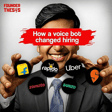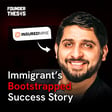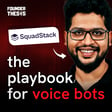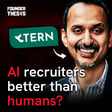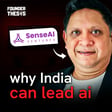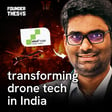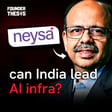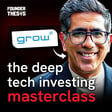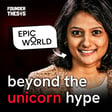Become a Creator today!Start creating today - Share your story with the world!
Start for free
00:00:00
00:00:01

Digital public infrastructure for assets | Shreyans Nahar @ Finsire
Shreyans reveals a groundbreaking solution to address the inefficiencies in traditional lending. With the innovative platform Sheru, he is on a mission to reshape lending norms by considering a diverse range of assets, from stocks and mutual funds to cryptocurrency and NFTs.
For more such interesting founder journeys, subscribe to our newsletter www.founderthesis.com
Read more about Finsire:-
1.Borrowers must be proactive in managing their loan repayments, says Shreyans Nahar of Finsire
2.Fintech startup Finsire raises $1.3 million in seed funding
3.How would a blockchain network help the lenders and borrowers
Transcript
Introduction to Finsire and Motivation Behind Its Creation
00:00:00
Speaker
Hey folks, this is Sirans, the CEO and co-founder of Finsire, a dead-still infrastructure for assets.
00:00:20
Speaker
Shreyant Snahar quit a well-paying job in finance to pursue an MBA from an American Ivy League school. And then he had a most illuminating experience when he tried to apply for an education loan. Despite being cash rich and having enough savings to not really need a loan, he was denied the loan. And the reason was that the bank would only give a loan if he could produce a proof of owning an asset like a house.
00:00:44
Speaker
This is a glaring inefficiency. The bank lost the opportunity to give a loan to a profitable and a low risk customer simply because it couldn't factor in all the different forms of assets that an individual can own, like stocks, mutual funds, cryptocurrency, insurance policies, NFTs and many more. This put Shrayans on a mission to solve this problem and ultimately led to the birth of Finsire.
Vision and Investment in Finsire
00:01:05
Speaker
Finsire is building the pipes that will allow data about all the assets you own to flow to you or other parties you consent to share it with. The fact that this can be a revolutionary technology is evident from the list of angel investors who are backing Finsire. Stay tuned for a deep dive into the world of digitization of asset ownership and how it can unlock value for you and me. And don't forget to subscribe to the Foundry thesis podcast on any audio streaming app.
00:01:39
Speaker
What led you to choose finance as the space you wanted to work in and which eventually became a space you wanted to build a business in?
Shreyant's Business Background and Lessons on Credit Risk
00:01:56
Speaker
There has been obviously a lot of sort of story that essentially has built up on this, right? I do come from a proper autorock smarty family that has done business for the longest.
00:02:14
Speaker
In both maternal and paternal, I don't know if there were any folks who worked 9-5 or in corporate jobs set up for the longest, like in my dad's generation, both maternal and paternal. It was my cousins who initially started working there.
00:02:37
Speaker
The credit business is actually a very interesting business that the family has seen all through and me while growing up because most of the maravadis and most of the folks from the society, from this part of society actually are in different forms of credit. Some take up security, some take Acre loan credit, some take vehicle financing, some end up doing code financing.
00:03:01
Speaker
It's a very interesting sort of a current or a culture that you see here because many of them are like these entrepreneurs are these characters in general. For me, it is a very interesting story. I had to kind of get into nine to five very early on because I'd seen the cycles of family business. Like during when I was growing up, probably it was high and then I'll take it later. I've just seen it fall down drastically through my own eyes.
00:03:29
Speaker
And in a way, it had its own beauty only because of the fact that while I could see the riches, I could also see the flip side of being in a proper credit business. I mean, it's not an easy business to run. If anything, it has to be one of the hardest in terms of risk because of the probability of repayment or the probability of someone.
00:03:56
Speaker
defaulting is unknown despite all the models that have ever existed. It is an emotional sort of a decision that one takes if one cannot pay at a given part of time. And on the other side of it also needs to be controlled in such a way.
Transition from Family Business to International Finance Career
00:04:12
Speaker
What went wrong in your family business? Was it regulations or was it NPS? Sure, it is a mixture of all, to be honest. I've written this elsewhere as well, but I'm happy to share it in the description. But ideally, what family had seen was that initially when they started off, I'm talking about right after independence in 1952 or something. And at that point of time, it was very interesting in the whole landscape of India.
00:04:39
Speaker
you know, formal credit players, most of them were informal. And the business was open for all in different segments. My granddad obviously got into giving loans to farmers based on, say, the produce that they had for the previous year or the previous six months. There was one kind of, you know, loan that he used to give. There's another loan that he used to give on gold. And the third type he used to give, basically, was give loan and take up a chunk of the business, much like what modern VCs do.
00:05:07
Speaker
So he had obviously built businesses around his own initial threat business. The downfall actually came much later, say 30 years of seeing rainbow and golden sunshine period was when actually a lot of banks and NBFC spread out in 1980s in India. A lot of them got privatized, a lot of NBFCs actually got kind of erupted in terms of giving out license.
00:05:30
Speaker
His business model obviously took a joint. People now realize I'm actually getting credit for just being interested and one does not take my business or one does not see my produce of the previous month and just previous year and just gives me credit on that. He used to get lump sum credit from these various plans and by these lenders as well.
00:05:50
Speaker
Right. So the actual downfall is twofold. One is obviously the competition that erupted drastically, which had forced him in, you know, my granddad getting into unsecured sort of lending. I mean, he's never done unsecured for 30 years. Right. Like, and then suddenly he's forced to do an unsecured because people didn't have. And that's when, you know, things went haywire. Bunch of NPA's then erupted post in unsecured lending. You know, 91 was a very interesting time and he lost a lot.
00:06:20
Speaker
fair bit of amount of money at the given point of time. And stories of the fact that retail business is also about to curtail because of debt availability and then he had to pump credit over here as well as a few bad decisions in mismanagement of pumping credit elsewhere. And obviously to top it all, he obviously lived in a very informal segment. So most of his investments also were in the informal side, like by real estate or property, so on and so forth.
00:06:47
Speaker
He had done obviously a few bad misjudgments in investing in wrong properties that obviously belonged to the government and a lot of issues with respect to that. So everything had a domino effect with respect to the business. So his personal investments also went wrong because of the investment in business, which is why a lot of learnings through this process. His was easily an empire, probably built out of Chennai.
00:07:12
Speaker
And it took probably 30-35 years to purchase a paper, probably took less than 5-6 years to actually take it all away. So that was a very interesting phase to see and to learn and realize how something like this, you know, kind of, if there's any business or that that can decide some required business.
00:07:31
Speaker
So, you had to take a job to support your family, or because you saw that joining the family business is not an option? Yeah, I mean, the doof was, I think you answered both. The interesting part was that, you know, at a given part of time, when he used to do business, like, my granddad, probably in the 80s and 90s, he used to do business with Tirobai, right? Like, when he had, you know,
00:07:57
Speaker
in Polister, when they started off, they had something called Vimal. He was leading the whole of Vimal for South India. That was a very interesting experience. When he used to lead Vimal,
00:08:13
Speaker
He probably was one of the top shots in the country for the whole of South India person, because that was only selling like hotcakes. And post that, obviously, a bunch of businesses with different kind of businessmen like Kishore Bani himself, like the fusion group of sorts, various businesses that compress of this.
00:08:33
Speaker
The fall was so drastic because of the credit business that it eventually led that, okay, not a lot of people were required for the business at all, and the supportive business at all for the credit. And I was always told that I'd probably join the family business and make it a lot bigger because almost all of my cousins were in the business. I didn't know anyone who basically worked 9-5 or wanted to work 9-5.
00:08:57
Speaker
It's very interesting and a new thing inside the whole bloodline itself. I don't know what I do. Families is obviously seeing something which is very different. It's not seen ever in the last 40 years or so. I have to probably make a choice and the decision has to see, do I get into something that has nothing left? Or do I do something that's very different?
00:09:21
Speaker
which obviously also led to me doing engineering. For someone like me, or someone in my already family, it's very unique to do with engineering, I saw it in the first place itself. So, I mean, I did engineering. I was certainly good at logics. I was pretty decent. I was definitely very smart, but I was super persistent. Like, I'll be dependent on understanding something. I'll probably be super persistent in learning the headcount of that. Job was a very interesting time because
00:09:58
Speaker
How do we increase the purchasing power? The only possible way for me was to get a job and have an additional source of income.
00:10:10
Speaker
It so happened that my first job was actually not in India, right? It was overseas. So I was actually excited for the, not for the job, but the fact that I would be, probably be earning in dollars. And, and it was in Hong Kong. I, you know, I had this gig and, you know, I used to own Hong Kong dollars, uh, used to save up some money and, and, you know, send back home, uh, you know, where it was left, so on and so forth.
00:10:31
Speaker
And that actually kind of increased the purchasing power so much so that I could feel like from the time when the last few years where I had to think of buying something twice is a lot getting easier at that given point of time. And I could probably plan and stuff a lot better than usual.
00:10:53
Speaker
What was the job that you were doing? How did that lead you to entrepreneurship again? Sure. So, I mean, a very interesting sort of a job, like the fact that I did engineering at VIT. I was obviously good in economics because I've been learning economics all throughout.
00:11:16
Speaker
My first job actually was, you know, you come here to Hong Kong. So it was part of the government, again, a few institutions and the government. So like a PPP project and storage just go there and figure out, you know, what do we do? So there are a bunch of projects that people are working on that to just pick one.
00:11:34
Speaker
I picked the one that obviously paid the most. Interestingly, I'm here, I'll probably make a few dollars and get financially liberated because the last whatever years have been super tough. The only possible way to pick something like that was something that had a lot of
00:11:56
Speaker
supply, but less of demand by takers. So I ended up picking up the most boring sort of a project that was using infrastructure damage. So much so that when I used to explain to people of SARS, people used to get lost within 20 seconds or so.
00:12:16
Speaker
And interestingly, at that point of time, in 2017 or so, 16, 17, not a lot of people are actually working on this. At a given point of time, there are 2,500 people who would actually work on something like this, like predicting when will Shanghai 101 fall, operating when will Macaud get damaged of SADs, taking the past data, linking to the future data, and just building models around it.
00:12:41
Speaker
Why would someone do this? Why would a company spend money on predicting? Like I said, it was a PPP project by the government and by the institution of SARTs. So basically the government was interested in curtailing,
00:12:57
Speaker
It was residents, earthquakes, in Hong Kong, and in another Hong Kong, right? So it was the Hong Kong government who was willing to do it for, let's say, the mainland China as well as Hong Kong sort of building, so on and so forth.
00:13:12
Speaker
I did that, they spent a lot on it. The budget for that was supremely high because they've seen past pain because of these stars falling, so on and so forth. If one could control that and get some sort of an accuracy to it, there would be something which is in their gamut.
00:13:33
Speaker
Was this for like saving lives or was it like my asset will be depleted by this date, so I need to keep the corpus to replace it? Was it like a financial angle or saving lives? I mean, so the government thinks obviously in multiple ways, right? The government obviously thinks, how can I probably save lives at a given point of time? How can I?
00:13:56
Speaker
Even if I have to demolish it or kind of do rehab to it, so on, so forth, how much, when do I start doing this?
Innovation Opportunities in Asset Management
00:14:04
Speaker
Then the whole idea that, okay, fine, there are a lot of development taking place around, say, Shanghai Ono, but that tower is probably getting old.
00:14:14
Speaker
So the government obviously had multiple angles and on the report, we had to put all of this, right? Like say, you know, you have to probably do rehab to it within say the next two years. If not, you know, things might go wrong. There would be another track. And the whole, the whole, these, the process of it was very kind of interesting. And I have a very interesting thought to share, right? Like you are obviously, because working for, say,
00:14:38
Speaker
you know, the Chinese governments, say the Hong Kong government, so on and so forth. The way they think is actually very different from, say, any other country, like both China and Singapore. That's what I worked for the next two years with the Singapore government. But both the same profiles. Yes. Right. Like the way they think is actually something which is very unique, which I am kind of
00:15:03
Speaker
satisfied because I worked my initial few years there, and I didn't work and say an American entity or say someone from the west of Saads, they do is actually very interesting. They actually dumbed down every sort of a problem statement so much so that it's impossible not to understand. You don't have to go and ask your colleagues, you don't have to go and ask the mentor or your boss again on how to do a certain problem statement.
00:15:32
Speaker
The ability to dumb down amongst Chinese step by step blows my mind. Sometimes I used to think, how the hell can someone even dumb down so much so that it just makes it like the whole process more seamless and in a very stimulation sort of a scenario. I'll just probably give an example. If I ever had to give a report back,
00:15:57
Speaker
to the government and say that, you know, this is what the process includes for us to kind of do the rehab and make the changes. I would actually have to tell that, you know, right from the part that, you know, open gate 7A first, right? If there's a crack in like 7A sort of a section, you'll have to open gate 7A.
00:16:19
Speaker
keep the keys and the lock tied down to the door and then go up six, you know, sort of six feet high, put a ladder there, then put go to six feet high and then, you know, kind of make those changes like that. Those steps used to be so strenuous to think that as simple as just, you know, making a small change of a rehab for a scratch or a breakage that has been that would have to give at least 10 to 12 steps involved in.
00:16:45
Speaker
and and and it is good and bad good that you know you can probably lead teams like this very you know kind of you know in a
00:16:55
Speaker
non-stressful manner, bad as that you curtail innovation or straight thinking from one side. Say for example, if it was in India, I would probably just go on a call, go to this particular door, make the changes and come back. And you don't know what's happening. But here, the ability to fail also is a lot lower in the Chinese way. You've got to think that because your steps are just so straightforward and stupid,
00:17:18
Speaker
You cannot fail again, right? Like, there won't be failed tests again. Yeah, it's idiot-proof. Exactly, right? So, that was very interesting, which is what we had to do with the government and pass on the reports
Developing a Comprehensive Asset Ledger
00:17:31
Speaker
and stuff. So, I did that for a year and the next two years I can spend with Singapore government, again, across this.
00:17:39
Speaker
And now it is not just infrastructure, now it is, you know, say 3D printing, say medical, and so on, so forth, spread across architecture, spread across various sort of risk models. Again, we used to build risk models for various scenarios. There is obviously a learned a lot more. That simple is actually a proper simulation.
00:17:58
Speaker
I think the whole country is extremely well-built, great leadership. And the orderly matters are not more than that. So it's just impossible to fail. And so I did that for two years. I think probably the best work that I've ever had by myself, only because the government is supremely forward thinking it forward. When you have something like that, no operate also can match the government level because the budget is just way too high for them to throw money and get shined up.
00:18:28
Speaker
Um, yeah, I mean, so videos in that, uh, most of the U S was that and, and yeah. Well, that studied that. What did you do in the U S? So I, I started first, I went to study that very interesting story. Again, the fact that I was in Singapore, I think I thought it would probably just settle down here. Uh, in those three years, I made enough sort of, uh, uh, money than I, that I've never probably seen. And, and, and, and.
00:18:55
Speaker
a year in Singapore actually was, was equivalent to what my dad made in 10 years. So essentially in the, in the, in the tough time that is right. Like, so I was like, you know, this is like crazy, like you saved up so much. And this essentially gives us a super power to do whatever you want to do. Right. Like very early on, I was like, okay, fine. I have 23, I've made, I've made it and I have enough to kind of do whatever I see at 23, 24.
00:19:19
Speaker
My choices were like just to either just continue working here and live here for the rest of my life or move elsewhere. I've done that actually whenever I felt comfortable, I just kept moving, realizing that, you know, if I don't experience that, then probably I'll have a very skewed thought of the words.
00:19:38
Speaker
I moved to the U.S. I studied there. I did my master's at Columbia. I had like decent opportunity to work there as well with a few folks. One of them was, you know, Stan Van Neuenberg was a professor there. He also used to be like the fund manager for that Norwegian fund. It's a trillion dollar, right? Like him and his client of sorts. He used to be a mentor of that.
00:20:02
Speaker
I mean, so I built like in this models. I mean, that's the only thing. And then I actually had a fair idea. So I'm going to build models again, across CDOs, CMBS, Structured Finance. And yeah, I mean, you were evaluating risk for their investments, like bonds. Yeah. So those are structured, those are real assets, like infrastructure, houses, real estate.
00:20:30
Speaker
Those were the asset classes, and I used to be very good models here. I mean, that was fun. My job also at Wall Street included doing almost the same thing, building models for real estate, so on and so forth. I mean, it was pretty good. The learnings were very different as to what I did earlier, but obviously, risk is a very homogeneous thing. It's multi-dimensional.
00:20:54
Speaker
or is a very homogeneous one thing, if you know and risk, you'll actually just do it for every other thing based on the variables changing, right? Like so finance sector, the variables change, the health sector variables. But if you know how to build models, you'll actually be very terrific at it.
00:21:09
Speaker
I did that. The US actually brought me to the world. I did come from a very capitalistic sort of a notion or an ideology. The Wall Street and the whole American set up that obviously gave me a whole different perspective of capitalism.
00:21:27
Speaker
while there are a lot of other forms of government, I don't think that there's something that exists as beautiful as capitalism. So I was so driven by doing that. I was like, how does one create more value in terms of asset classes? How does one build a repository for asset classes? How does one map asset classes of single vendors run over and beyond? These thoughts kept recurring onto my head. That obviously gave me a lot of sleepless nights thinking that
00:21:56
Speaker
If being a hedge fund guy in the U.S., I get to see 34 different asset classes, why couldn't the common man see it kind of easily, right? Like, shit like that. Obviously, think and believe that at some point of time, every asset would get digitized at some point of time, like, how we have information of math, the problems, that information of, you know, our personal details, like other, you know,
00:22:21
Speaker
But at some point of time, we will have for almost all the assets that one owns, like the one we own. And that was a very interesting phase, whereas thinking about all of this, why hasn't the government built it yet?
00:22:37
Speaker
Even the US government has not built something like this, where an individual can see all his or her assets at a click of a button. When they could probably do that, it's scattered with different kind of regulatory bodies or repositories that you have to go knock separately to get your own data and to do functions with your own data. And that was when I started flipping. And when you think of it,
00:23:00
Speaker
The top rich folks actually do have an opportunity because they do have personal bankers for themselves. So the personal bankers does and takes care of all of it. If one has to pledge, they pledge their shares or pledge their shares of shares, pledge their derivatives. It goes very deep. They have all the opportunities to play in the whole capitalism.
00:23:19
Speaker
I'm sort of a set up but you never find every anyone else actually do that like in fact even you don't find millionaires do that because they don't have personal mentors at ease like so that's when I start thinking that this is something that eventually we will do it it has to be in a public infrastructure and infrastructure that is put out just for identification of swords.
00:23:37
Speaker
And then pondering around this made me believe that I had to probably make a move very soon, which is why I curtailed my work at Wall Street, and I decided to move somewhere close. The reason I obviously moved back are multi-fours. I mean, I openly tell this, and this is actually something that is
00:23:59
Speaker
It matters a lot more to me than what I do today is that my family was getting old. My parents were getting old and I've been nine years away from them as I cannot do it. This was during COVID as well. I think emotions had struck when I learned that I decided that since this is the way I probably...
00:24:21
Speaker
I quit on a Wednesday. Look, I booked my flight on Friday to come back to India. And that's how close it was. And I was like, okay, let me just leave. Interestingly, I got another gig in Singapore. So I thought that was pretty close to home. So I might as well work here for some time and pick up some skills, which I did for some time. Now, it was not a risk anymore. It was actually a lot to do with infrastructure. I realized I wanted to get in this line of business.
00:24:51
Speaker
What do I do to learn and then see how it is and stuff. The whole Columbia tag obviously helped the idea that I did graduate and work there. So I started working in API infrastructure. I learned fairbit. So I worked nine, 10 months there. There's like FinTech API infrastructure, like say M2P, FinTech. No, it was not M2P. I mean, that wasn't long. So it was like a SaaS sort of an API infrastructure. So
Integration with Existing Systems and User Benefits
00:25:18
Speaker
it was integrating, you know,
00:25:22
Speaker
the software with a bunch of other project management softwares or financial institution softwares, like credit softwares basically. So, one could actually not do bills of payments, one could settle the contract value, one could do the payments of the contract value, one could see the duration of payment of the contract value.
00:25:45
Speaker
So this was a standalone software, and we had to integrate multiple other softwares that are here. So I did that work. It was very interesting because in that nine months, my only work was actually integrating softwares and softwares. Integrating every month, or at least one or two integrations that go by.
00:26:04
Speaker
This was built for lenders, so that lenders can get access to data about invoicing, etc. No, so this was basically built for projects. So say, for example, engineering projects were there, and engineering projects would have not just the data of work, but also data of build, so on and so forth.
00:26:25
Speaker
So this basically was used for heavy engineering, construction companies, any sort of projects that potentially oil and gas, any sort of project that potentially has a lot of documents and bills and so on and so forth, payments and financing that goes into it was actually done through the south.
00:26:45
Speaker
And this would improve the efficiency for the oil and gas company? Yes, this would in turn improve their efficiency, a new mode of payments, a new structure of digitization of whatever earlier payment modes were done and digitization of earlier documentation and contract management that was pretty much done. Okay, so the manual work which was happening because there were multiple systems that basically got digitized.
00:27:15
Speaker
Okay. Yeah. That was actually a very interesting lot only because whatever we do in Finsetra today is very linked to integrations, right? Like since ours is like proper interest out of our business, it just includes way too many integrations and, you know, the stakeholders involved. So the ability to
00:27:40
Speaker
to integrate softwares and ability to push them out is supreme at something like us. So when I finished integrating the eighth to the ninth software, I decided I probably learned whatever I had to learn. It might sound like some form of another capitalism, but I thought the utility of learning and integrations was pretty much bad to speak. Anything beyond would probably be me just doing it and not in superior learning of sorts.
00:28:10
Speaker
Again, it was obviously the time moment I felt I was comfortable and was well set to, and probably one had to make a move. I was still pondering upon that whole problem statement that struck me when I was working at One State. I realized that I had to speak this out to someone.
00:28:30
Speaker
And that's when my co-founder and I, we used to almost talk every day about various things. Like we've been great friends for 16 years. Both of us played football while growing up. He probably was the best footballer I knew him to as well. We played at decent professional leagues as well. So essentially I realized that instead of someone I would want to do something, it's idly, but it was an open up.
00:28:54
Speaker
And we discussed about this. Interestingly, Mridul also had worked on a similar thesis before that, and he came back to India in 2018 to start another company, much of what we do in FinSAT but in blockchain. So something like this obviously is very possible in blockchain or the ability to do it is actually
00:29:14
Speaker
A lot higher, right? Like you're not talking about holding the data of individuals in a private repository, but in a very public repository, you're trying to do that. So he decided to do that initially for about a year or so while I was doing that.
00:29:27
Speaker
Obviously, when he started reading, there's not a lot of lookers because the whole thing caught up, caught on fire only, say, during code or postcode. So there were a few challenges, which is when we were discussing something of sorts, what we wanted to do. We realized that we have to do probably the same thing because it's too good to be a problem statement or not to be solved.
00:29:53
Speaker
And we decided to start something like this in proper sort of database system, but holding like with multiple, including the regulators in close of the repositories, getting the lenders on and on. And, you know, kind of the distribution as well and eventually kind of, you know, ensuring that something like this can be done in a public infrastructure as well, right? Or should I say what UPI has done for payments as a public infrastructure, much like what, you know, according to the data law that has done in the public infrastructure.
00:30:20
Speaker
I think something like this can be, it's surprising that the government at scale, I'm sure they'll probably be thinking of it, but something like this has to be done at that level. The whole identification part of data at least needs to be done in that level.
00:30:36
Speaker
Over and beyond that, what you do with the data, what the consumer wants to do with the data, that can be secondary. That can be as what Finsight does today. Over and beyond that, we build use cases around it so that the consumers can leverage that out. But the initial phase of it, the identification part of it, in simple terms, can still be done in a very public infrastructural manner where the government has an intervention and can see your time and time again.
00:31:03
Speaker
Let me zoom into the idea, which you originally got while working at Wall Street and now you are trying to implement at Finsire. So what you're saying is the ultra rich have access to utilize their assets in better manners. Like if you are in need of money, you don't need to sell your house or sell your car or whatever.
00:31:25
Speaker
have your house mortgage and you can take a loan against it or if you own a piece of art that artwork can be valued and against that value you can get a loan and using that loan you can invest in the stock market because you know stock market is going to rise and make money and so therefore your assets are more liquid you can take money out through credit and use that to make more money and so on and so forth
00:31:53
Speaker
For ultra-rich, it's possible to do that because there's a private banker working with them who can do things like assessing the value and working with a lender who lend against that assessed value. For the rest of the people, they don't have this. So what you wanted to create was
Challenges in Real Estate Mapping and Data Integrity
00:32:12
Speaker
a legend of assets and covering multiple asset categories, be it art, be it property, be it vehicle, be it bonds, be it gold, whatever. So is that, is my understanding, correct?
00:32:27
Speaker
Yeah, I mean, yeah, I mean, that's a fair understanding. I mean, very few people getting the first. Yeah, that's right. I mean, it's like a like a black box on a possibility of multiple assets. And these multiple assets are handled with a positive. So it's like a positive or a positive. And essentially, when you have these assets at your own gamut, what happens is that a ledger is definitely a good way to put it as well. What happens is that now
00:32:56
Speaker
You can first identify your assets. You don't need to go to multiple places. As simple as the stocks, you may be holding the stocks, some from Zeroda, some from Grow, some from your HDFC security, so on and so forth. Inclusive your family as well, they'll be holding these multiple places. Actually, it's very, very hard. Even as simple as that, when you want to pledge, see the shares from Zeroda.
00:33:22
Speaker
The lender would only kind of, you know, see all the shares itself. He cannot or she cannot see all of this. Yamad wants to put together. It's only if you take the effort of downloading the sheets and then going and giving to lender and then eventually transferring all the shares to one particular broker, you'd eventually kind of get a credit on that. It's a very hard process, not a very pleasing process.
00:33:46
Speaker
And this actually is for all asset classes, right? Like how do you even do it for all asset classes? I just spoke about one asset class, right? Like in India, the known asset financial asset classes itself are 16. And if you consider how the rich leverage a lot more, they probably use something else, different classes also of asset classes, right? Like some use their interior furniture as well to be pledged and then eventually get credit on that and how do you do that, so on and so forth.
00:34:13
Speaker
So RTS is not just credit, credit is a byproduct of various kind of use cases or solutions that you can do with these assets. But as simple as even putting a down payment, as simple as putting as a collateral. Today, if you have to go and put something as a collateral was the first thing a lender would ask or a transaction had asked or an underwriter asked, give me a property papers.
00:34:41
Speaker
You know, India and the world has never heard something else beyond that. Have you ever heard, you know, give me your, you know, share details or your mutual fund details. That is a collage. It's a very funny thing that, you know, despite having all of these assets, one has not thought of putting this as a collage. Because if I'm going on board, take an education loan of what they say, 10 to 15 lakhs or so. And if you ask me to put a property worth one and half two crores, it doesn't make any sense to me at all. Why would I even do that to begin?
00:35:09
Speaker
I could probably be using this to get a business loan and start another business line. So these thoughts have tripled down quite a lot. For everything that we do today, as simple as collateral or of sorts, we still put the house papers at the house document. Firstly, because you don't have any other form of asset that you've identified so easily in the ecosystem or you don't have that ability to do that.
00:35:37
Speaker
And because the systems are so archaic for the lenders, they're just happy seeing the paper hard as it formed and not do anything which is now digital of science and nature. So there are a bunch of these use cases, but definitely credit is one of them and can be noted. So essentially you're building the ledger and how that ledger is used, there are multiple ways to do that. Why did you call it a black box? Why did I call it a black box? Yeah.
00:36:07
Speaker
Oh, yes. I mean, so having these multiple assets at once, because you probably see only one asset max at one, every given point of time, you've got to think of it like a switch or a black box, right? The thing is, say for example, you go for a certain, you know, kind of an education law. And I like education law and so what so, because I never got an education law from the Indian banks. I had probably approached like six, seven of them. All of them visited my application.
00:36:35
Speaker
This is obviously because my family never owned a property. We had to sell off income proof salaries. My family never owned a property. We had to sell off property during the crisis that we had. We had a bunch of gourd and mutual funds and life insurance.
00:36:53
Speaker
But that would not be accepted by the by the lenders and the writers. So property is the only thing and banks kind of rejected operates and left center all on this despite me getting into like say Columbia of sorts. So I was like very shocked and then I didn't want the loan. So I just probably wanted it.
00:37:09
Speaker
some portion of it so that you need me in getting the visa as well because they'll probably be slipping around how does this one you know do have so much money in hand and then that was a thought and that was mostly because of the fact that I earn any decent in Singapore so I was like okay find you guys and I'm gonna give me a loan it's okay and right it's not a I want something of that sort but say imagine someone actually wants an education loan of sons.
00:37:33
Speaker
And say one has about six different sorts of assets, like just say your stocks, your military funds, your life insurance, your property, your gold kept in a locker, and say pension funds that you'd have to kind of guess. Six different asset classes probably, these are the minimal asset classes that almost everyone would have at a given park.
00:37:54
Speaker
And these asset classes now are in this ledger or are in this black box of sorts. And it's actually a switch knob. Say, for example, now if you want to go dig this, and FinCERT obviously is integrated with that, they put out your number. That is a unique identity that's mapped out to you. They put out a number.
Legal and Regulatory Considerations in Asset Digitization
00:38:14
Speaker
And once they put out a number, you get a certain RTP.
00:38:17
Speaker
and you put in the OTP with your consent, the idea is that obviously the transaction or the lender at a given point of time would see all of these assets, which is what you've given your consent for. Now, once they see all of these asset classes that are put together, they obviously try to map
00:38:34
Speaker
your loan amount do it. Like say they can probably take 125-130% of the loan value or say the LDB to be somewhere about 65-70-80% of sorts. They'd see which asset class kind of maps onto it. If say the first one, you don't have enough stocks, it'll probably switch and go to the mutual funds. So you have enough mutual funds of sorts. So now the mutual funds gets click and say for example, you want to select one of your life insurance, even that get key.
00:39:01
Speaker
So one fails, like a switch, it goes to the next one. The next one fails, like a switch, it goes to the next one. So it fills in and takes these two asset classes, the optimal asset classes that you actually need to give to get this loan. You don't need to kind of end up giving, say, about, you know, whatever, two crores to get like about 15 lakhs more.
00:39:18
Speaker
So, this switch actually today we see in payment companies, right? Like, say, you know, certain companies, like just pay, so on, so forth, solves if one payment fails, it goes to the next payment. The other one fails, it goes to the next payment. Are these that can we do that with assets, like when everyone, everything is put together?
00:39:33
Speaker
albeit the consent again to select which you want to pledge is still given to the user. So the user still can select, I want to pledge stocks 1, 2, 3, 4, mutual fund 2, 3, 4, and life insurance 1. They could even do that. So that switch is given directly to the users as well.
00:39:51
Speaker
So next time somebody accesses your assets, they will see some assets are already pledged. So they'll be grayed out. Or they'll be like a net worth, which is calculated by assets minus the liability. The liability will also be entered on financial.
00:40:13
Speaker
Yeah, so both is that. So exactly, right. So we would obviously give you the data. We are not a standalone app or a platform. Obviously we integrate with the likes of other companies who have distribution. So you can obviously see your network and there's a public portal, essentially like an repository like I said, that will also be out for us, essentially to say that
00:40:35
Speaker
which is more like a non-profit, right? Like because you're building this in a very public infrastructure, you want to be as transparent as possible and to answer. So NetNet, you'll obviously be able to see what is pledged, what is not pledged at a given bar, and the lender will be, with your concern, will be able to see what is pledged and what is not pledged.
00:40:50
Speaker
This also reduces a lot of mistrust in the ecosystem, meaning if someone has placed a property or given a fake document for the vehicle of sorts, it cannot happen again.
00:41:07
Speaker
Obviously, I've seen it in my own family as well, where one of the bad decisions that was done was actually something like this. One property document was circulated amongst three people, and that was very interesting to know that while payment had been done of two and a half to three crores, you're talking about someone else also holding the property. Something like this is there.
00:41:33
Speaker
Why are we still not solving it? So something is obviously restricted and ensure that these fraudulent acts do not take place as well.
00:41:42
Speaker
No, interesting. You said that there's a non-profit element in that. Can you zoom in on that? What is that? Yes. Sure. So the non-profit is only the public infrastructure that I'm talking about. It's a supremely important right of individuals, I feel, that one gets to see or identify all of their assets in one place. So you're saying that the ledger will be non-profit?
00:42:10
Speaker
Yes. So the identification of the assets would be the nonprofit. And what is the for-profit part of this? So anything beyond that is what comes for profit, right? Like say, for example, today on account aggregator also, you can probably see all of your information and assets of SADs. For us, it's the same thing, right? Like it's an extension of the AA, where you can probably see all of these assets at once, but up on aggregator, only if someone comes and participates, will you even be able to see those assets.
Strategic Partnerships and Growth Strategy
00:42:37
Speaker
And what happens for certain kinds of assets that would never be participating in the AA? So we obviously would cover all of the other environments. The idea is that, and obviously put that on the ledger and with users' consumption and number and the OTP, one can basically identify all of their assets at once at scale. And then eventually, if they want to show it as net worth or a proof, that's where they can particularly show it of sorts.
00:43:03
Speaker
The for-profit is actually anything beyond an afterness. If one has to, say for example, get an education loan on this, if one has to get a plain vanilla credit on this, then it will be on any other side.
00:43:21
Speaker
use this as a down payment of buying something which is a lot more expensive in nature. Something like what say Bajaj Finance is not solved for. Bajaj Finance is solved for all these low ticket, zero AMI sort of things. Anything which is beyond a certain value, same one and a half times, you have to give a down payment today.
00:43:39
Speaker
Someone can use this as a pledge for the non-payment of sales and payout directly. Those shins that come beyond what you do, these asset classes we have integrated with those companies out there, these are for profit. So you charge the lenders for the right to access and pledge or carve out the assets. Yes, that's right. So we directly charge the lenders. The consumers do not get charged.
00:44:07
Speaker
I said distribution, right? So there is a certain charge for the distribution as well in terms of platform fees, so on and so forth. Like say if we have to create this through Google Pay, right? So on one end of it will be the lenders, one end will be us integrating with these hypotheses, and the third end will be all Google Pay's distribution, right? Or consumers.
00:44:28
Speaker
can this kind of, so as soon as they enter global, they can probably put their number and see on the assets. So eventually, a thesis that we don't want to create our own distribution, because creating a distribution actually becomes a lot harder. And thesis rather, how can we integrate with folks who have already built up distribution in India for the last 10 years or so, and latch onto them, which makes complete sense, a use case. Like Red can be one of them. The distribution app
00:44:57
Speaker
will do this for free or they will charge you or you will charge them? It works in two ways. Obviously for leveraging distribution, there is a certain sort of scent that they get. And for doing anything beyond that functionality, obviously they do get charged. Like even at the end of the day, if they are getting into something like this business, like say, pair it of sorts.
00:45:20
Speaker
They need the whole onboarding process that you need those APIs for it, so on and so forth, which obviously we have in the house, we give it to them. And beyond that, there's also something like, on their own compliance and reporting, they need to build a software for that. We obviously have that also in the house, so on and so forth. So reporting compliance, everything becomes a lot easier. Reporting compliance for what? If I have given a loan to somebody, then I need to
00:45:48
Speaker
prepare to report that this person is still solvent. This is not an NPA. That is what you're talking about. Yes. So the lenders do that in one perspective of it. Even the distribution will have to kind of, you know, report to RBI, so on and so forth, right? Through my app, you know, my... Report what?
00:46:03
Speaker
the data of users, like how much has been pledged, who has pledged what, what is the total number, what all assets have been pledged for what use, as soon as someone takes up a loan, how much time that is left for completing the loan. These are the things that they need to report to various stakeholders. Some of it is also to the, some of it is directly to us in the lender of sorts, and some of it is for their own in-house to understand who's taken what, so on and so forth. So this reporting,
00:46:34
Speaker
software that is built. Why does a Google pen need to report all this? Every NBFC which makes a loan would be sending a report to a credit bureau. I mean the credit bureau is the party collecting and this data.
00:46:50
Speaker
Yeah, so that's the NBFC, right? Which doesn't have a distribution. Here I'm talking about how do we create a distribution. If FinSight is doing it by ourselves, even we may have to kind of report it to the kind of respective bureaus and stakeholders involved. Not just that, even if some kind of audit takes place, you need to kind of compile and give the data as well. So even that eventually comes down to that. And so eventually we don't have to give.
00:47:13
Speaker
But because we are not kind of creating our distribution, we're not having our own app of sorts to, you know, to say that, boss, you know, come directly download through and to app store, replace them. And, uh, that's only for testing and for people who don't have the solution. People have the solution that I understand, right? Like you will see us that integrating like API and sign giving it.
00:47:33
Speaker
So let's say Google Pay integrates this. Will Google Pay get a revenue share when a lender is accessing this for the customer and the customer uses Google Pay to access? Yes, of course. So that is where even they make money out of it as well. Like on a net net.
00:47:55
Speaker
It's a very interesting sort of a case. If you believe that payment companies or if you believe that distribution companies have created sticky distribution for an decade now, you have to believe that they'll obviously garner a lot more over the next whatever 5 to 10 years as well. A lot more Indians will charge. Someone's already created such a beautiful distribution. I mean, one has to think, is it worth my time to create my own distribution or is it worth my time just latching on to them and doing it?
00:48:22
Speaker
And to obviously give to whatever they have done, we would obviously give there's a certain revenue share of the lending amount that eventually kind of goes in. Okay. So this works only if the quality of data is good. Like, you know, you give that example of one person who sold that property to three different people, the same set of documents.
00:48:52
Speaker
So how do you ensure good quality data that this is actually what he owns? With a high degree of confidence that the lender has a high degree of confidence. If on the FinSci database it says he owns this property and this property is worth one crore, then I trust that.
00:49:15
Speaker
Yeah. So the, uh, for something like this, actually it's very, uh, uh, very interesting. And the reason is that, uh,
00:49:27
Speaker
There's probably the hack that I have.
Future Expansion and User Base Growth
00:49:30
Speaker
And this hack is actually very interesting hack that I didn't say. So building something like this, you need three things. PDU is supremely important. One is that every asset class needs to have a unique identity, a unique number that is put to it. Like say, if I have to map the property that you own in Bandra, second street, that will have a sort of a number plate.
00:49:58
Speaker
Second one is that these asset classes need to be held by a central repository. It can be multiple, like your two-three repositories and all that, but it has to be L-based and your repository for it. Like a municipality would hold records. Yes, you can be a sub-register, can be T and so on and so forth. So the central repository is important to it.
00:50:22
Speaker
And the third and the most important thing, it's funny that a fintech says this, but it's actually very true. It has to be regulated. If it's not regulated, then it's going to be super hard to do that. These three are the three most basic fundamentals of doing something like this that cannot be fastened. So obviously, I would know that once, if it's all three are the stakeholders and all three are involved,
00:50:49
Speaker
The data or the movement of data flow is actually a lot easier. Now you can just map all of this, like say a residential property in Tamil Nadu, which is part of X, Y, Z, or Sriyans. T and Dera holds the data. And if I want to transfer it, I need to kind of tell them again and the transfer views are put out. And the ability for me to give it is tracked and freestyle.
00:51:19
Speaker
So there are other asset classes that do not fall into these three categories. I mean, if they don't fall into these three categories, it gets very challenging. Let me just zoom in on this one first and then we'll talk of the other asset categories.
00:51:36
Speaker
Okay, so you have a unique identifying number for every property. Let's stick to the real estate example. How do you map it with the users that this property belongs to this unique user? How do you get that data? Because let's say maybe the land records, the TN will have a name of the owner, and there could be multiple people with the same name. There could be a misspelling in the name.
00:52:04
Speaker
How do you do the last leg of mapping the ownership with the asset? Yeah, especially in the land, it's a supremely big challenge here. It's a challenge that we already face here. It's not easy. There are multiple boards, there are multiple municipalities that are out there. Sensei, one of them, T&R out on them, CDMA one of them, the sub-registers, one of them, so on and so forth.
00:52:30
Speaker
Cracking down asset class by asset class itself is a pretty big challenge like you know residential, commercial, agriculture, warehouse, sports storage also. So I mean you have to dissect and play that first you have to see which asset class you're going after then you have to see who folds which the body that folds on this now every action that they do
00:52:50
Speaker
Firstly, it's only digitizing themselves first and then identifying. So it's a process that is not a straightforward process and every state has its own process. But this process is what will lead to a lot more streamlining and a lot more sort of...
00:53:10
Speaker
efficiencies in how this data is transferred. So we do select based on asset class. Post asset class, we see which repositories help and identify the repository, it is tested the repository. So now they probably use the tech that the rails that we have or if they don't use that, they want to use the existing work and API would obviously kind of showcase any sort of change that is then with respect to certain property.
00:53:38
Speaker
So, every pledged property would go on set of signs. So, every pledged property is already there and non-pledged would be held by still by these repositories of sorts. So, there's a mapping that is done of this sort. It's not an easy challenge. Bring your hearts into track. We're not sure if we have
00:53:58
Speaker
if we'd be able to do all states, but I mean, that's the hope. Eventually, if we were able to do all states, all asset classes in this form and mapping each repository, and it's a very different sort of a mental map in that. Eventually, you cover obviously $7 trillion worth of asset classes, which is only in real estate in India, and that's a huge number in itself.
00:54:23
Speaker
So this would only work if two things are true. One is that the authority which owns this data is digitizing. Second, they have some sort of KYC. Like with a KYC, if they have, let's say, the Aadhaar number, then it becomes easy to map ownership.
00:54:42
Speaker
Yeah, so KYC of this is also there. So one has to do KYC of this as well. The other ownership needs to match. Also some that is not done before in terms of KYC or in terms of knowing who the actual owner is would be done in this process itself. Typically digitization and KYC will go hand in hand.
00:55:07
Speaker
Real estate is, so my understanding is real estate is probably the toughest example to talk about among the asset classes you want to do. Tell me about a relatively easier asset class. What are the low-hanging fruits? I think the easiest asset class is the ones that are already distressed. And I say something like a stock or a mutual
00:55:29
Speaker
Because this KYC done and things straightforward, right? Like stock and that is something that is supremely taken one that you know who the owners are. It is held by assembly repository, every sort of unique identity for each ownership. The ability to move, lean mark has already been set up by those APIs by different repositories.
00:55:53
Speaker
Lenders understand this very well already. So it's a very straightforward sort of, you know, sort of an integration that, you know, so the harder ones are of course real estate.
00:56:09
Speaker
Gold, you know, gold held by houses, I don't think that'll probably, that'll be the last that comes out in dollars of data. Like, why would someone even, you know, kind of give the data. But when you think about it on the retrospect, if one wants to show their network, I mean, you have to do that. That's what is accepted and you have to probably not take it. But how would you control that the person declares, I have this gold and it doesn't sell it off?
00:56:31
Speaker
That would only work if there's like a gold repository or some gold banker who holds your gold and issues you a certificate of ownership. You're right. Which is like the lockers in gold today, they can be distanced. The gold lockers can be done. The lockers themselves would not know how much is a gold, but the end user and while selling those data, so on and so forth. So lockers can be done.
00:56:56
Speaker
There are these two, but the golden household and real estate. Even in real estate, there are few that can be done, say commercial real estate. That can be done quite easily. People who own the properties, who understand the business really well, they keep flipping properties. They do play with credit quite a lot. So they understand that really well. The hardest is obviously farmland or agri-land.
00:57:27
Speaker
Likewise in gold, gold held by households, that becomes a pretty hard thing to know. How would you ascribe it to fair value? Let's say we're talking of commercial real estate. How do you ascribe it to fair value? Because the value keeps changing, going up and down, and there are so many intangibles, like the location, and if metro station comes up, then the value will suddenly go up, and so on and so forth.
00:57:53
Speaker
I mean, that's a very interesting question, actually. So I was just speaking about this to someone.
00:58:00
Speaker
Like most of the other asset classes, they have an ongoing sort of public value put to it. Like sales, stocks, mutual funds, every day you probably have a public value that comes and gets on it. Something with real estate, it's a lot more. The demand supply is a lot more. So something like the other asset, the demand supply is actually the whole sort of the listing and then people on that listing buying and selling of sorts.
00:58:27
Speaker
I think sort of a set up that is already done. There's algos that have to be done and the set up is already done. But unless and what do you do? It is it is not safe.
00:58:37
Speaker
Real estate property in Mumbai is increasing, so real estate property in Chennai also should increase. But see the stock value over there and here would obviously be the same. Likewise, the gold value would be more or less the same of sorts. So it is actually the price that is around that real estate value. Today, as of today, the whole idea is that to keep the transaction value of orders put out last as the value now. And obviously, as years have progressed, the rise in real estate price or the value there.
00:59:07
Speaker
But say if you bought a house, say about five years ago, the transaction value is I would say two cross or so. But today you think it is to be sold at say two and a half. We would probably not. We would give you estimated value to be two and a half. And the actual value is still the transaction value that you did last. Right. Okay. Got it.
00:59:25
Speaker
Now, you said there is a second type of asset class where these things are not possible. What was that? Were you talking of gold in households? I mean, so there were quite a lot, actually. Art. Art is one of them. NFT is another one. That is not held by a simple repository. What do you do with that? NFT should be huge. I mean, it's a digital asset. That's still possible. A proper art is not possible. You cannot value a proper art. A proper art is still not possible.
00:59:57
Speaker
you know, the whole thesis of NFT encryptors, then they don't want to get regulated like this, or they don't want it to be covered in the ecosystem in terms of the value like this, right? So someone who works... Yeah, anonymity factors. So you need to have them declare that they own it, like you need to remove the anonymity. Exactly. So it is an antithesis to whatever they stand for as well, right? So something like this gets extremely
01:00:23
Speaker
There would be folks who actually own it, but want to show it and then pledge and partake on it. But at the same point of time, this whole anonymous sort of scenario comes in. So it gets tricky. So there are a bunch of it that eventually is going to be super challenging and tricky to do that. But as long as there's an underwrite to do it, and as long as these three functions are followed, I think it is possible. And that is about 16 different asset classes that is possible in India.
01:00:52
Speaker
Okay. Why don't you do this on the blockchain? Because we are talking of a ledger and we're talking of doing it in a non-profit way. If you combine these things, you just add decentralization, then it becomes a blockchain. I mean, you could, right? Which is why I said like, you know, Virgil had started something like this on a blockchain before.
01:01:15
Speaker
It is possible. I mean, it's not like it's not possible. You feel blockchain will face more resistance of adoption. Yeah. I mean, which is what has happened, right? Like we just start and there are a lot of resistance in adopting it. Lenders would not accept it so easily. Underwriters would not do it. The whole regulatory body is just kind of, you know, appreciating blockchain, but you know.
01:01:41
Speaker
to believe that the other forms of it that are there are not kind of, you know, sustainable for the country. So there are a lot of stuff. I mean, when you don't kind of, you know, bet against the ones who probably don't want to write, who want to, who are writing the story for the country, right? Like we bet against the regulators, regulations that blend us. When you start off on a bad note, it's not like it cannot be done. I'm sure it can be done. I think that's the right way to do it as well over a period of time.
01:02:08
Speaker
You know, one country believes that the trust ecosystem is being solved for it. I mean, like you probably see this to be on a blockchain, whatever we have for the NPO, the nonprofit would actually be on a blockchain. But at the moment, when every other repository also is doing in a database way, if you know the other way, I think it's, it's dumb to be busted. So the moment you talk blockchain, you're just adding noise to your story. You have a very focused story. The moment you add blockchain,
01:02:38
Speaker
Some people will come on board just for speculative reasons and some people will avoid it because of fear of speculative. I mean, it just adds noise. Got it. So I understand what you want to build. Tell me what have you built so far.
01:02:55
Speaker
Yeah, so we have mostly built for a few asset classes already and in part of use cases, right? So we have built for earned salary, we've built for mutual funds, we've built for stocks, life insurance identification is already, you know, kind of prevalent, EPF for identification is already prevalent and so on.
01:03:11
Speaker
So there are months of it that we already have, there are customers for it, they are using it, so on and so forth. So the true value of it comes with it. Tell me for each of these one by one, how you built it. How did you build for earned salary? And why earned salary in asset class? It comes with flow, right? Yeah, it's a funny story as well. When we started off this year and a half, plus plus and low,
01:03:36
Speaker
No repository would give us an API as well. And even till there, they give an API only to a lender. They don't give it a third party technology service provider.
01:03:46
Speaker
And I think that as it kind of is funny and bloom I might, I'm like, you know, if I don't have to start, I have to start with something that is a lot more liquid and flowable in nature, which was on salary because it's not salary, it's on whatever is there. And that acts like an asset class of someone who, then I can probably, you know, see that, okay, this much money is in a bank account. I can probably lend out that if you want to, I can give you that much money for me and so on and so forth.
01:04:10
Speaker
That is where we started off. And how did you do that through account aggregator framework? Yeah. So we did a bunch of things like, you know, there are a bunch of rappers that are obviously there. You know, folks who obviously got data from, you know, we got data from folks who we used to get kind of, you know, get their salary details and so on and so forth through corporates and the corporates that they work for, because these companies were integrated with HR administrators.
01:04:35
Speaker
So we used to get that data from multiple sources and multiple businesses and eventually kind of, you know, plug it with that. And that's how we started. The primary source would be payroll softwares, basically. Yeah. Payroll softwares and companies that have integrated payroll softwares. Right. These are things that have integrated payroll softwares and, you know, kind of take the data and get the data from then and eventually kind of, you know. What kind of companies are these? I have not heard of them. There are a bunch of other API companies out there.
01:05:00
Speaker
So there are a bunch of other repair companies that primarily focus on getting salary data from payroll and software as well. But this is a small part of Indian salary payout. Only 10% of salary payout would be going through a payroll software. Yeah, very small. 90% would be unorganised. Yeah, it's still very small. It's still very, very small and not a good thing. But we had to start off somewhere.
01:05:29
Speaker
This is the only idea that, you know, none of the other sorts of, you know, tabs will open for us to do it. Okay. You know, so that you're, you know, kind of go and leave and realize this, you know, these repositories, like say, NSTL or CAMs, CVS still hasn't, you know, still doesn't have APS equipment. CAMs is a mutual fund, like they have data on mutual fund. NSTL is equity. They have data on equity that is wrong. Yes. Okay. Yes.
01:05:55
Speaker
and K Fintech. What does that hold? So that also holds for mutual fund data. So CAHMS and K Fintech are like sharing market. Yes, for mutual funds. So that asset class then got covered.
01:06:16
Speaker
There are a bunch of other asset classes. How did you convince these people? Cams, Kfintech are like legacy companies. You are like a 20-something kid, almost, in front of their eyes, going and telling them to give access to your data. So now they have started giving the third-party players. It was not just me, but many folks like me would have knocked at their doors to say, your data, your data.
01:06:43
Speaker
Which lender is working with you? So we have a bunch of lenders. We have TJFC, we have Liquilons, we have PKF and others. We have a couple of others on the wait line. So there are a lot of lenders out there. So you would have gone to CAMs saying that we represent these lenders and they want to access your data through our pipes. So we are printing the pipes. Yeah, so we had to do that at the end.
01:07:07
Speaker
So, yeah, I mean, so it is very interesting. So now a lot of these players who had these data are now opening up slowly one by one to give out the data. But this CAMs and all would not have given you like the fire hose of data. They would have just given you when a user is seeking a loan, then for that use, I will give you data.
01:07:32
Speaker
No, cams will give an EPA itself of the data, right? Like cams themselves would have an identification of assets with the user's content. So if you put out your number, cams with the EPA will get bigger and then the users, all the mutual fund assets of that particular users, which obviously, you know, have the dematerialized one, the ones that can be seen.
01:07:58
Speaker
will be shown on the whatever integration device that's been integrated. So, CAMS actually gives it on the plate, but obviously there's some work that needs to be done beyond for the distribution that we can send us, but they do give a bunch of OTPs and bunch of consent, you do get access to that data. So, you're collecting person by person or CAMS has
01:08:20
Speaker
allowed you to access the entire database of mutual fund owners? It is entire, with the consent of the particular user. How could you have gotten consent of millions? Because we are talking of millions of mutual fund owners. Yeah, so that is why there is a certain number that one puts his or her number. OTP gets sent. Did you actually have millions of people giving you the OTP?
01:08:49
Speaker
That's what I'm trying to understand. Yeah, so we don't have a million users at the moment, but at a given point of time, yes, million people would be using it and the OTP would be going back and forth from say the users to the repository, not the repository, the repository pushes the data. It's like a messenger that collects the data and gives it to that user's device.
01:09:13
Speaker
These letters are using these pipes to give out loans. When data is traveling through the pipe, then it is also getting added to the ledger.
01:09:26
Speaker
Okay, so the more the number of lenders use it, the more data flows through the pipes, the more data gets added to the ledger. So more lenders or more people in general, right, distribution of same more people from Google to end up using more people from other sorts of human application use it.
01:09:43
Speaker
It gets mapped onto that one particular, which our lender kind of sees it and have an access to it, so on and so forth, and approve whatever kind of trade wants. The ability for this ledger or the ability for something like a black box like this is that one is obviously the switch, two is the whole bit of financial sort of logics to it. The idea is that
01:10:05
Speaker
When you have one asset class, the volatility is obviously a lot higher. When you have multiple asset classes, the risk reduces drastically, the volatility is a lot lower. So a lot of things actually change, which now with asset classes and we have itself, we are noticing and witnessing. You'll probably realize that
01:10:23
Speaker
The LTV of course, is increased now, it's nowhere, you know, your LTV being near traditional 50, 60 percent, your LTV is increased. What is LTV? Loan to value, right? Before that you loan to value, not as a. So, 60 percent LTV means, I have an asset of once crore, I will get 60 lakhs of zones.
01:10:41
Speaker
That's right. Now your LTV is increased. Two is the interest rates. You prefer your interest rates used to be a lot higher. Now the interest rates are a lot lower because one of secured asset, two, multiple asset being secured. Three, and the most important thing, I mean, something like this is actually very true that a lot of H&Is get access to it, but a lot of obviously common ones do not get access to it is something like a loan duration.
01:11:08
Speaker
Usually, when you think of a loan duration, the longest loan duration that you'll actually get is, say, a house loan. You'd probably not get a bigger debt. But every other asset class is actually very curtailed. It is done based on the credit risk of the income. So if it's single asset, put together.
01:11:24
Speaker
But now what we have done with something like this is that because the assets are clubbed together, the maturity of the asset as a bundle, as a bundle has increased drastically. So the maturity period has increased drastically for the asset class.
01:11:45
Speaker
Because the maturity period has increased drastically, your loan duration also is in your course. Now I can think of before having an education loan only of 5-6 years, now it's put down to 15-20 years based on how my maturity of the asset classes are. Rich actually knew this game quite well, kind of increasing their loan duration to 30 years of SADs.
01:12:06
Speaker
because your net net EMI that you pay is actually very negligible. Your interest rates are low, net net EMI is very negligible. So at the end of the day, your interest payments are actually more or less the same. You should not matter quite a lot, but you're okay to push out for the longest.
01:12:27
Speaker
Okay, got it. So you've done income through the payroll companies, you've done mutual funds through CAMS and KFintech and you've done shares also now through NSDA? Yeah, NSDA. And that is again the same thing like a lender requesting for share ownership proof and the data is traveling through the pipe, it gets added to the ledger. Yeah, and does the same thing. Okay, okay. So how many users
01:12:52
Speaker
you have data on how many users like what is the number of I mean that's based on the lender usually the number is not good but that's based on the lender you know but your ledger is building up that data right yeah so we do do that yes we have to say about four lenders they have given over say 25 or different sorts of distribution channels that they have and the users of that they use right so there are you know
01:13:15
Speaker
The users aren't fired, is it? Like, you know, that pretty much have you said, like, you know, 12,000, 13,000 plus plus have easily kind of accessed. So like the size of your ledger currently is about 12, 13,000. Like there are 12, 13,000 unique users on the ledger. So this was before we raised.
01:13:36
Speaker
So before we connected, yes, it was about 13,000 to 15,000 that simply got done and a lot of people had access to it. Now obviously it's a lot more. I don't know, I need to check those numbers, but it's a lot more than what it was. Maybe 20,000, 30,000, something like that. Less than 50,000 is the number of people for whom you have asset information.
01:13:58
Speaker
What is your target that you want to hit by whatever cell milestone that you have in mind like say your asset information of 1 million users by its date. I mean if we have a so the thing is if we have like a great distribution.
01:14:15
Speaker
say something like Google, right? Like handed service, you're talking about people. And, you know, even a one person of Google, they're talking about huge numbers. So they're not in that phase where we are now going and trying to build it with distribution of sites.
01:14:31
Speaker
But obviously, build with more asset classes. Today, we have these three life inference data can be seen, so on and so forth. And beyond that, there's a lot of integration that is going in-house where we integrate the other asset classes and then directly integrate with the distribution.
01:14:48
Speaker
How did you get life insurance? What is the authority which has that? So, a bunch of players do have it as well, with respect to NIR, NSDL, so on and so forth. There are a bunch of players who just have identified the date, but over and beyond, there is not. So, over and beyond, for doing an action on it, you still need to work. So, that's work in progress. Okay, got it.
01:15:14
Speaker
And so what you're saying is the moment you crack one partnership, this number of 20,000 could come 2 lakhs in a matter of a month or two. Yeah, so there's a lot of... Exactly. So there's a lot of... And there's not just a partnership, obviously a big partnership. Today we have a lot of partners. Our next moves
01:15:36
Speaker
The current partners today are basically lending apps like say somebody has a liquid loan app on their phone to apply for a loan. So that is what you're calling as distribution.
01:15:48
Speaker
Yes, so them and a few tech first apps as well. They're relatively very new. So they themselves are finding their own path, but obviously they are also... Give me some examples. Oh, there are a bunch of them. So DGFC has also got a distribution that is out there, and they have their own tech application, which is very nascent given out to their own...
01:16:12
Speaker
you know, kind of SMEs that, that SMEs sort of, you don't use that. So there are bunch that... Use it for what? Like what's the use case for these apps? Their use case also is credit. So their use case is also credit. Okay, okay, okay, okay, okay.
01:16:27
Speaker
But something like ET Money could also be a big unlock for you. Because ET Money also has quite a large user base. And people on ET Money are anyway there for managing their investments. So this becomes an... Yes, exactly. Anything like Zerodar or anything like that. Which is why part of the reason our investor base is also spread across. We are investors. Either they've been in the industry for the longest.
01:16:56
Speaker
And they understand this business really well. Are there potential customers? So, I mean, all of our investors get chosen and picked in such a way that eventually there would be some sound integration. How did you raise funds and how much have you raised? How did you raise funds? I mean, like, so I raised funds, it was a very tough market. I mean, it was not an easy market. Till then, it's not an easy market. I mean, it was an experience in itself to say that
01:17:27
Speaker
You know, the market's gone. We have left the job. Not many companies farming, companies shutting, if anything.
01:17:37
Speaker
Our initial few investors actually were infra players who were doing a lot of other things, but not doing something like this. So this was like a, this is what like it was an eyeball casual, like to think that, okay, if one could have access to the data and one could use this data with permission and do a lot good, this would probably change a lot of kind of, you know, volume. That's also because
01:18:02
Speaker
When you take credit as an example, still till today, secured credit is obviously in terms of value a lot more than unsecured credit in the country. Secured credit is what makes or breaks the country to begin with.
01:18:17
Speaker
So essentially, you know, it was that, and, you know, as one, two folks came in, I did believe that a lot of them would close in and come and participate very soon. So this whole process closed in very soon after that. What were the infra players who invested in you initially? Fintech infra. They came in the same round. Fintech M2P is invested in us.
01:18:44
Speaker
So the founders of M2P that is, then founders of Razorpay. Yeah, this is an angel round. So these would all be like basically angels. So this is not an angel round. So this was like, we have about five or six more funds that have invested as well. Okay. This is more like a pre-series.
01:19:06
Speaker
Yeah, there's a proper seed. We have like, you know, likes of Spark, Capital, DevX, IC, Adept Ventures, Portal Ventures, then 1947 Rise, and, you know, a bunch of mega sort of angels who, you know, together participate in this.
01:19:28
Speaker
So the initial part was to sell the idea to some angels and then they would have helped you to further connect and that got the momentum going. Yeah, I mean the momentum was obviously like I was at it. I mean, I was supremely persistent. I'm like, you know, something like this doesn't get started. How many pitches did you make?
01:19:49
Speaker
Oh, by a lot. I mean, like don't ask 300 plus like 300. Not 300, not 300. I mean, like to get a first yes, I probably made 20. That was pretty low. I mean, not a 20. I mean, the first yes is actually the easiest. It was less than 10.
01:20:11
Speaker
But to get anything beyond that was a little hard. And after that, almost every pitch was getting converted into a funded. So we have like about 35 odd. Getting the first one was easy. Getting the two to five was obviously like, wow, who do I not talk to next? Because everywhere, markets are shining.
01:20:33
Speaker
5 to 35, almost every call was a yes. Because the first 5 had come in, that built credibility. Yeah, so the first 5 built massive credibility and it was every call, it was like, yes, yes, yes. But yeah, overall, I would have done somewhere about, you know, 70, 70, 100, yeah, 70 to 100 of which is 35, 100. Amazing, amazing.
01:21:04
Speaker
And that brings us to the end of this conversation. I want to ask you for a favor now. Did you like listening to the show? I'd love to hear your feedback about it. Do you have your own startup ideas? I'd love to hear them. Do you have questions for any of the guests that you heard about in the show? I'd love to get your questions and pass them on to the guests. Write to me at adatthepodium.in. That's adatthepodium.in.

